The Archbasilica Of Saint John Lateran, often simply called the Lateran Basilica, stands as the cathedral of Rome, holding a position of unparalleled significance within the Catholic Church. It is not only the ecclesiastical seat of the Bishop of Rome, the Pope, but also the Papal Archbasilica, claiming precedence over all other churches in the Catholic world, including even St. Peter’s Basilica in Vatican City. This venerable basilica is the oldest public church in the West and ranks first among Rome’s four Major Basilicas, each holding papal status. Its history stretches back to the earliest days of Christianity, intertwining with the narrative of the Roman Empire and the papacy itself.
The site upon which this magnificent basilica stands today was once occupied by a Roman imperial cavalry bodyguard fort. This fort was the stronghold of the guard who fought for Maxentius against Emperor Constantine in the pivotal Battle of the Milvian Bridge in 312 AD. Constantine’s victory in this battle marked a turning point for Christianity in the Roman Empire. In the aftermath, Constantine dissolved the defeated guard and ordered the demolition of their fort. In its place, as an act of thanksgiving to God for his triumph, Constantine commissioned the construction of an early Christian basilica, dedicating it to the Savior.
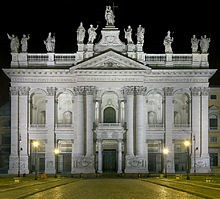 Basilica of Saint John Lateran Exterior View
Basilica of Saint John Lateran Exterior View
The land surrounding the fort, during the early Roman Empire, was the domain of the illustrious Laterani family, housing their grand Domus, or Palace. The Domus Laterani’s connection to imperial power deepened when Constantine married Fausta, the sister of Maxentius. Through this marriage, the palace and its surrounding lands transitioned into imperial hands. Constantine, in a significant act of patronage, gifted this prestigious property to Pope St. Miltiades. In 313 AD, Pope Miltiades convened a crucial council within the Lateran Palace, aimed at addressing the Donatist schism that was then challenging the unity of the early Church. While initially dedicated to the Savior, it was later, during the papacy of Gregory I (590-604), that the church was also dedicated to St. John the Baptist and St. John the Apostle, the writer of the Fourth Gospel, further enriching its spiritual significance.
A momentous occasion in the basilica’s early history occurred on November 9, 324 AD, when Pope St. Sylvester I solemnly presided over the official dedication of the Archbasilica and the adjacent Lateran Palace. On this day, Pope Sylvester declared both to be the “Domus Dei,” the “House of God,” signifying their sacred purpose and status. The Papal Cathedra, the Bishop of Rome’s official chair, was installed within the basilica, formally establishing it as the Cathedral of Rome. Reflecting its esteemed position as the “mother church” of Christendom, an inscription was placed on the front wall between the main entrance doors, proclaiming in Latin, “sacrosancta Lateranensis ecclesia omnium urbis et orbis ecclesiarum mater et caput,” which translates to: “Most Holy Lateran Church, mother and head of all the churches of the city and of the world.”
Every Pope following St. Miltiades resided in the Lateran Palace, underscoring the basilica’s central role in papal life and governance, until the papacy of the French Pope Clement V. In 1309, Clement V made the controversial decision to relocate the official seat of the Catholic Church to Avignon, France, marking a significant shift in papal history and impacting the Lateran’s prominence.
Within the Basilica and the adjoining Palace, five Ecumenical Councils, gatherings of the Church’s highest authorities to address doctrinal and disciplinary matters, were held. These pivotal councils took place in 1123, 1139, 1179, 1215, and 1512-1517, and are historically known as the Lateran Councils, further cementing the basilica’s place in Church history.
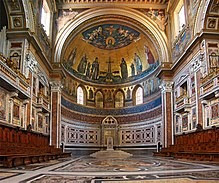 Photo of Archbasilica Interior with Columns
Photo of Archbasilica Interior with Columns
During the period of the Avignon Papacy, as the Popes resided outside of Rome, the Lateran Palace and the Archbasilica began to suffer neglect and deterioration. Devastating fires in 1307 and again in 1361 inflicted significant damage, diminishing their splendor. Although the Popes in Avignon dispatched funds for reconstruction efforts after both fires, the Archbasilica and the Lateran Palace never fully regained their former magnificence.
When the Papacy eventually returned to Rome, and the Pope once again resided in the city, the condition of the Archbasilica and Lateran Palace was deemed inadequate, particularly considering the accumulated damage of over seven decades of absence and neglect. Consequently, the Popes initially established their residence at the Basilica di Santa Maria in Trastevere, and later at the Basilica di Santa Maria Maggiore. Eventually, the Vatican Palace was constructed adjacent to the Basilica of St. Peter, becoming the primary papal residence. Popes resided in the Vatican Palace until Pope Francis’s decision to reside at the Domus Santa Marta, a guesthouse within Vatican City.
Numerous attempts were made throughout the centuries to restore and reconstruct the Archbasilica. However, it was not until the papacy of Pope Sixtus V (1585-1590) that a comprehensive and definitive plan for reconstruction was implemented, spearheaded by the architect Domenico Fontana.
Fontana’s ambitious project involved the complete demolition of the original Lateran Palace, which was then replaced with a new, more modern structure, better suited to the needs of the papacy and the Church.
In the square situated in front of the Lateran Palace stands a remarkable monument: the Lateran Obelisk. This obelisk holds the distinction of being the highest and most ancient obelisk in Rome, a city renowned for its collection of thirteen obelisks, more than any other city worldwide. Carved in the fifteenth century BC, this imposing monolith originally graced the Karnak temple in Thebes, Egypt. It was transported to Rome and erected in the Circus Maximus in 357 AD. Over the centuries, it fell into disrepair, breaking into pieces and becoming buried beneath the Circus Maximus. Rediscovered and excavated in the 16th century, Pope Sixtus V had it restored and placed on a new pedestal in 1588, positioning it at the northern entrance to the Archbasilica, where it stands as a testament to Rome’s layered history.
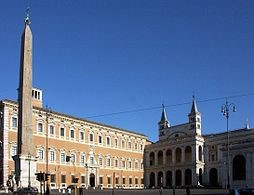 Photo of the Lateran Obelisk
Photo of the Lateran Obelisk
Pope Innocent X (1644-1655) commissioned the renowned architect Francesco Borromini to undertake a significant renovation of the Archbasilica’s interior. It was during this period that St. John Lateran, as it is often called, began to develop a distinct architectural character that differentiated it from the other three papal basilicas in Rome.
Borromini’s design retained the nave with five aisles, a feature shared by the original St. Peter’s Basilica and still present in the Basilica of St. Paul Outside-the-Walls. However, in the central nave, Borromini introduced a unique and striking element: twelve large niches set within a lofty white framework. By 1718, each of these niches was filled with a colossal statue of an apostle, sculpted by prominent Roman Rococo artists. These grand baroque figures of the apostles, while a defining characteristic of the Lateran, are surprisingly often overlooked in guidebooks, yet they offer a powerful visual and spiritual experience. These vibrant statues invite contemplation on the lives and martyrdom of the individual apostles, each accompanied by significant symbolic attributes, such as St. Bartholomew holding his flayed skin, a graphic depiction of his martyrdom.
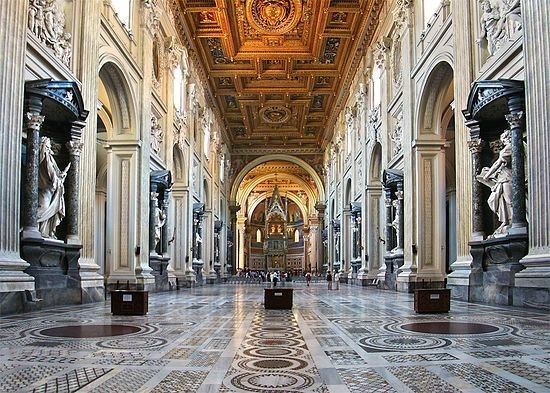 Interior View of the Archbasilica with Apostle Statues
Interior View of the Archbasilica with Apostle Statues
Positioned above these imposing statues are high reliefs executed in white stucco, designed by Alessandro Algardi in 1659. These reliefs depict scenes from both the Old and New Testaments, creating a visual “biblical concordance.” Algardi and his collaborators ingeniously juxtaposed scenes from the Old Testament that prefigure events in the life of Jesus, the Messiah. For instance, one side of the nave features the Old Testament story of Jonah emerging from the sea serpent after three days, mirroring the New Testament scene of the Resurrection of Christ on the opposite side of the nave, highlighting the typological connection between the two testaments.
Pope Clement XII (1730-1740) initiated another ambitious phase of reconstruction, focusing on the basilica’s façade. The design was entrusted to Alessandro Galilei, a relative of the famed astronomer Galileo Galilei, and was completed in 1735. The resulting façade presents a grand, palace-like appearance, rather than the more traditional façade of a church. An inscription on the façade, in Latin, reads (translated): “Pope Clement XII, in the fifth year of his reign, dedicated this building to Christ the Savior, in honor of Saints John the Baptist and John the Evangelist,” clearly stating the basilica’s dedication and papal patronage.
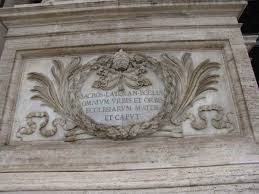 Exterior Facade of the Archbasilica
Exterior Facade of the Archbasilica
Five doors provide entrance into the basilica. The rightmost door holds special significance as the Holy Door, which is opened only every 25 years for the Jubilee year, a period of special grace and pilgrimage in the Catholic Church. The ritual of opening the Holy Door for the Jubilee was first performed in this Basilica by Pope Martin V in 1423, and was later extended to the other Roman Basilicas. Above the entablature of the façade are fifteen colossal statues. In the central position stands Christ the Savior, flanked by statues of St. John the Baptist and St. John the Evangelist on either side. These central figures are further flanked by the twelve Doctors of the Greek and Latin Churches, symbolizing the doctrinal unity of the Church throughout its history.
The sanctuary and apse of the Archbasilica are dominated by a magnificent mosaic created in the 13th century by two Franciscan friars, Jacopo Torriti and Jacopo da Camerino. The upper section of the mosaic depicts the Savior enthroned amidst the clouds, surrounded by a celestial host of angels.
The lower section of the apse mosaic presents a congregation of significant figures in Christian history and devotion, arranged from left to right: St. Paul, St. Peter, St. Francis of Assisi, Our Lady, St. John the Baptist, St. Anthony of Padua, St. John the Apostle, and St. Andrew. A smaller figure kneeling near Our Lady is a representation of Pope Nicholas IV, whose contributions to the Lateran were praised by Dante Alighieri in his Paradiso. Above the jeweled crucifix in the mosaic, the Holy Spirit is depicted as a dove, from whose beak water flows down the sides of the Cross, dividing into four streams, symbolizing the four Gospels, ultimately flowing into the Jordan River, depicted along the base of the mosaic, teeming with life. Stags and sheep, symbols of the faithful, are shown drinking the living water from these Gospel sources, a clear allegorical representation of Baptism and the life-giving grace of the Holy Spirit.
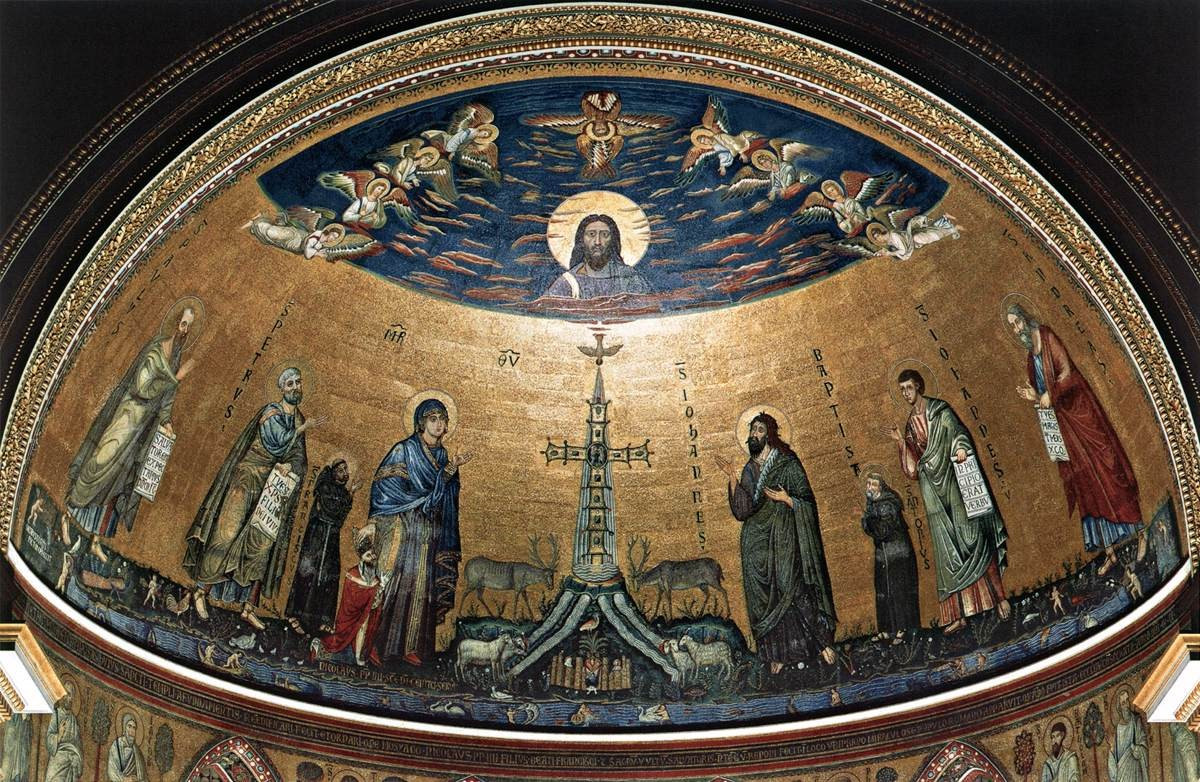 Apse Mosaic Detail
Apse Mosaic Detail
Reflecting on the symbolism of the apse mosaic, the text prompts contemplation of passages from the Gospel of John, particularly those relating to St. John the Baptist and St. John the Evangelist, the basilica’s patron saints:
“There was a man sent from God, whose name was John. He came for testimony, to bear witness to the light, that all might believe through him. He was not the light, but came to bear witness to the light” (John 1:6-8), highlighting John the Evangelist’s testimony about John the Baptist.
“Behold, the Lamb of God, who takes away the sin of the world! … I saw the Spirit descend as a dove from heaven, and it remained on him… I myself did not know him; but he who sent me to baptize with water said to me, ‘He on whom you see the Spirit descend and remain, this is he who baptizes with the Holy Spirit’” (John 1:29, 32, 33), capturing John the Baptist’s witness to the Savior and the Holy Spirit.
The basilica houses numerous significant relics, adding to its spiritual importance for pilgrims and the faithful.
The canopy, or baldacchino, situated over the high altar, dates back to 1369. This Gothic structure rests on four marble columns and is adorned with paintings. Within the upper part of the baldacchino are housed busts of the Apostles Peter and Paul. Tradition holds that the skulls, or parts of the skulls, of St. Peter and St. Paul, the foundational apostles of the Church, are enshrined within these busts, making them among the basilica’s most revered treasures.
Beneath the baldacchino stands the papal altar. While the altar itself is of modern construction, it encases the ancient wooden altar believed to have been used until the fourth century by the first thirteen popes, from St. Peter to St. Sylvester, to celebrate the Eucharist, connecting the present basilica to the earliest days of the papacy.
To the left of the Papal Altar is another ancient table, positioned above the altar where the Blessed Sacrament is reserved. This table is placed directly behind a bronze relief depicting the Last Supper. Tradition asserts that it was upon this very table that Jesus and his apostles celebrated the Last Supper, further linking the Lateran Basilica to the foundational events of Christianity.
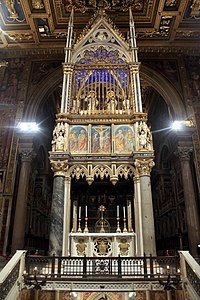 Photo of Baldacchino and Papal Altar
Photo of Baldacchino and Papal Altar
Just outside the basilica, within a small park, stands the Monument of St. Francis and companions. This group sculpture depicts St. Francis of Assisi (1182-1226) facing the façade of the basilica with his arms outstretched. From a certain vantage point behind the statue, it appears as if St. Francis is physically supporting the church building, an artistic representation of his spiritual role in the Church’s renewal. This pose alludes to the dream of Pope Innocent III in 1209. Innocent III dreamt of seeing the Lateran Basilica, then in a state of disrepair, being supported by St. Francis.
St. Francis, the “Poverello” from Assisi, had come to Rome with a small group of followers seeking papal approval for his new religious order and its rule. Pope Innocent III, sleeping in the Lateran Palace adjacent to the basilica, which was symbolically “on the verge of collapse” due to worldly concerns overshadowing its spirituality, had this prophetic dream. He recognized in St. Francis the man divinely sent not to restore the physical building, but to revitalize the Church spiritually through his radical embrace of poverty and simplicity.
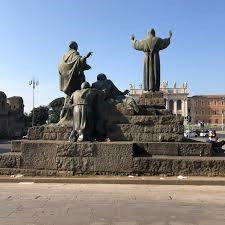 Close up of St. Francis Statue
Close up of St. Francis Statue
Within the basilica itself, another significant tomb is that of Pope Innocent III, whose papacy was crucial in recognizing St. Francis. The tomb depicts Pope Innocent III alongside figures of Jesus, St. Dominic, and St. Francis, commemorating his role in Church history and his connection to these important saints.
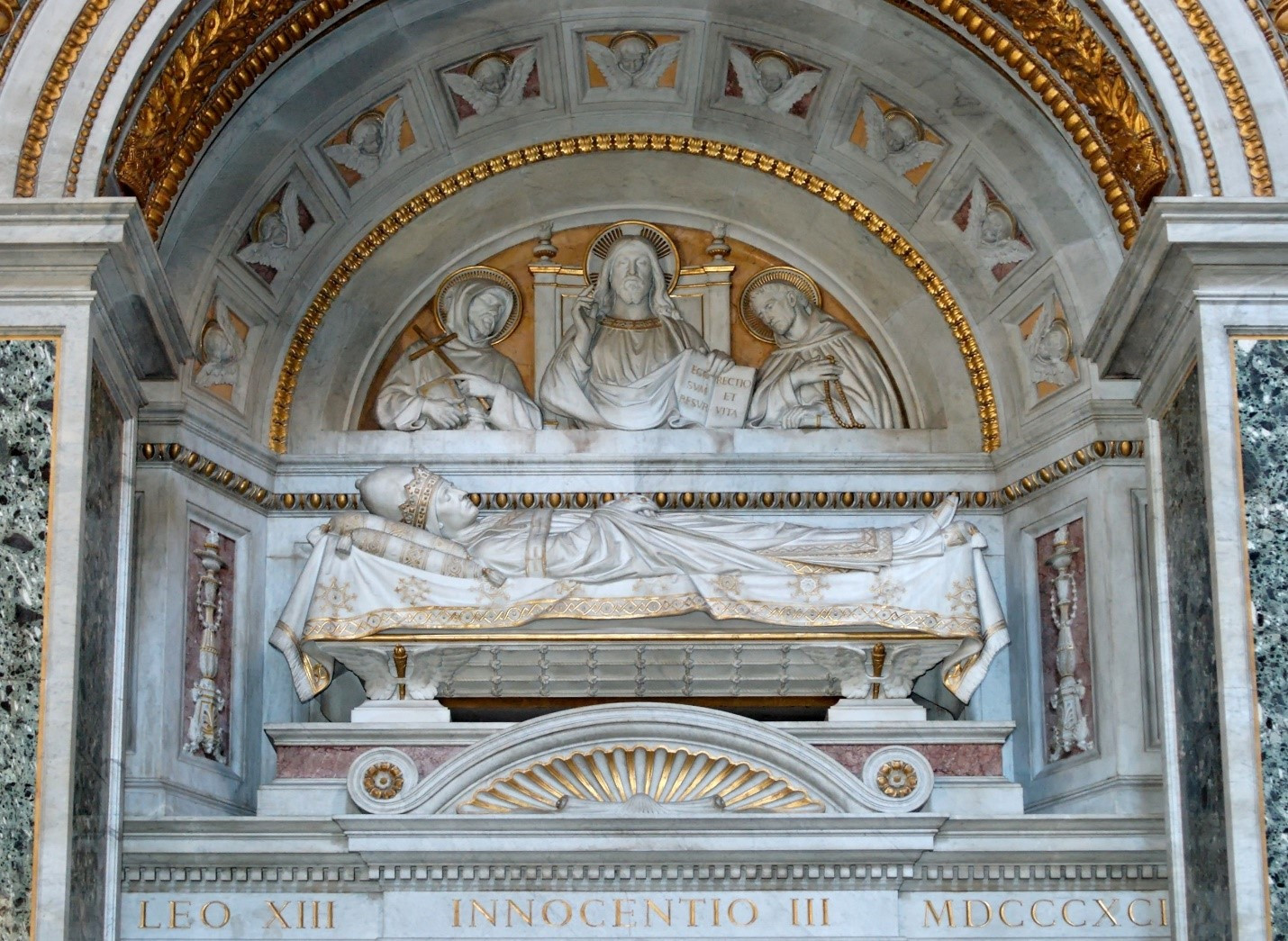 Tomb of Pope Innocent III
Tomb of Pope Innocent III
Nearby the Archbasilica is the Scala Sancta, or Holy Stairs. In 1586, during Sixtus V’s construction of the present Lateran Palace, he instructed Domenico Fontana, his architect, to incorporate the grand staircase from the old palace, composed of 28 marble steps. Legend recounts that St. Helena, the mother of Constantine, brought these steps to Rome in the fourth century from the praetorium of Pontius Pilate in Jerusalem. If authentic, these are the very steps Jesus would have ascended on his way to trial before his crucifixion. For centuries, pilgrims have honored Christ’s Passion by ascending the Scala Sancta on their knees as a form of penance and devotion. To protect the marble from wear, the Holy Stairs were encased in wood in the early 1700s. In 2019, the protective wood was temporarily removed for restoration, allowing pilgrims to ascend the exposed marble stairs on their knees for a limited time, the first such opportunity in nearly 300 years, before being covered again.
At the summit of the Scala Sancta lies the Sancta Sanctorum, once the private chapel of the Pope, housing significant relics and historically serving as a place of personal papal devotion.
The Baptistery of Lateran is not structurally integrated with the Basilica but stands as a separate, detached building in close proximity. It is the original baptistery of the Basilica, established by Constantine in the fourth century, making it one of the oldest baptisteries in Christendom. The building is octagonal in shape, featuring eight porphyry columns supporting the architrave, upon which rest eight smaller columns, also of porphyry, showcasing the architectural richness of the early Christian period.
In the center of the baptistery, steps descend to the basin that serves as the baptismal font. In early Christian practice, baptism was often performed by partial immersion, with candidates descending into the water up to their knees while water was poured three times over their head, a practice common in the West.
A frequently asked question is whether Emperor Constantine himself was baptized in this baptistery. While Constantine founded the baptistery, he was not baptized here. He famously deferred receiving the sacrament of baptism until the very end of his life, believing that baptism closer to death would minimize the opportunity for post-baptismal sin and increase his chances of salvation. He was eventually baptized shortly before his death in May 337 by his distant relative, Eusebius of Nicomedia, an Arian bishop, a detail that highlights the complex theological landscape of the early Church.
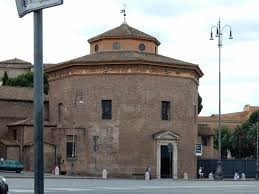 Baptistery Exterior
Baptistery Exterior
The Lateran Basilica, as the Mother of all churches in Rome and the world, holds a unique place in Christian history and devotion. Every year on November 9th, the Church celebrates the dedication of the Lateran Basilica, recognizing its status as the oldest and most venerable of all Western churches. Beyond this universal feast, each diocese commemorates the dedication of its own Cathedral, and every individual church also remembers its consecration day in a special way, highlighting the sacred significance of every church building as a house of God.
In Rome, a city with nearly a thousand churches, and indeed wherever one resides, the Lateran Basilica serves as a potent reminder to consider the profound reality that every church building is a symbol of God’s presence among humanity.
The Catechism of the Catholic Church, in paragraph 1279, elucidates the profound effects of Baptism, stating that baptismal grace is a rich reality that includes birth into new life, making one an adopted child of the Father, a member of Christ, and a temple of the Holy Spirit. Through baptism, individuals are incorporated into the Church, the Body of Christ, and become sharers in Christ’s priesthood. This understanding emphasizes the transformative and indelible mark of baptism on the individual and their relationship with God and the Church.
Reflecting on this, we are prompted to consider the profound truth that as baptized Christians, we are temples of God, and that the Holy Trinity dwells within us through grace, a reality that invites deeper contemplation and spiritual awareness in our daily lives.
The Archbasilica of Saint John Lateran stands not only as a magnificent architectural and artistic monument, but also as a living testament to centuries of Christian faith, history, and tradition, inviting all to explore its depths and discover its enduring spiritual treasures.
